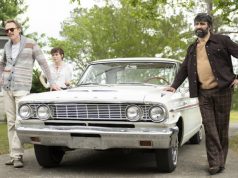A lot of eyes were on Morgan Spurlock to see what he’d do as a follow-up to “Super Size Me,” an out-of-nowhere documentary hit that became a cultural phenomenon and actually effected some change in the McDonald’s attitude toward healthfulness (though Mickey D’s denies the connection). With Michael Moore’s muckraking sense of mischief but none of his abrasive personality or blatantly unfair manipulations, Spurlock is the new poster child for nonfiction filmmaking that’s both useful and entertaining — and he achieved that status with just one movie.
Having tackled McDonald’s, the self-described West Virginia redneck now has bigger Filet-O-Fish to fry — one of the biggest, in fact, as his new project, “Where in the World Is Osama Bin Laden?,” follows his quest to find the world’s #1 most wanted criminal. The result isn’t quite the dazzling mix of comedy and education that “Super Size Me” was; in fact, you could come away from it wondering whether it actually serves any purpose at all. But I think it’s a solid sophomore effort, and proof enough that Spurlock is not just a one-hit wonder.
Spurlock frames the film around his wife Alexandra’s pregnancy and his desire to make the world safer for his unborn child. Bin Laden is the world’s most notorious terrorist, so why not get him out of the way? “If I’ve learned anything from big-budget action movies,” he says, “it’s that complicated global problems are best solved by one lonely guy.”
That joking assertion and the hilarious video-game-style opening-credit sequence that follows it indicate that Spurlock isn’t 100 percent serious about actually coming face-to-face with Bin Laden. He seems to know the quest itself is futile, and that the process is what’s important. (Not to be a spoiler or anything, but if he’d actually succeeded in finding Bin Laden, you’d have heard about it before you read this review. It would have been big news. I will say, though, that he comes a lot closer than the U.S. government has, probably because he was actually looking and we sorta gave up.)
The process takes him through some preliminary training that recalls his “Super Size Me” style, lightweight stuff like learning some Arabic, taking self-defense classes, growing a beard, etc. The content is negligible, but it reinforces Spurlock’s persona as a savvy, funny regular guy.
It’s when he flies to the Middle East that the film really hits its stride. His search for Bin Laden takes him to countries where the terrorist has left footprints, including Egypt, Saudi Arabia, Afghanistan, and Pakistan. He talks to ordinary Muslims in every country, and the message he hears time and time again is NOT that they hate America. They say quite specifically that they love America and American citizens. It’s our country’s foreign policies that they hate.
They also hate Bin Laden. They assert that he is not a real Muslim, and they’re frustrated by the bad name he and his ilk give Islam. Extremists exploit the conflict between Israel and Palestine to recruit more zealots, and they attract so much attention that it’s easy to feel like those zealots are the majority. Not so, say the everyday Middle Eastern citizens. “Moderates are the majority, but their voices are not loud enough,” says one wise man.
Spurlock presents a litany of facts and figures along the way, and here he proves, as he did in “Super Size Me,” to be adept at alarming us without being obnoxious or divisive. He is the diligent parent who sneaks vegetables into our food. He reminds us that one of America’s best buddies, Saudi Arabia, is one of the most repressive countries in the world, with an atrocious human-rights record, and that it’s rank hypocrisy for us to be so chummy with them while rattling our sabers at, say, Iran. What are Middle Easterners supposed to think about the U.S. when we live by such double standards?
The point of it all is to educate the viewer not on Bin Laden specifically but on the environment that produced Bin Laden. After all, he’s only one man, and no one thinks that getting rid of him would make a dent in terrorism. Much of what Spurlock tells us might not be news to you if you’ve followed the “war on terror” closely, but it’s a good summary and primer otherwise.
More important, I think, is Spurlock’s attitude: hopeful, optimistic, and eager to understand everyone’s point of view. He posits that if we can change the mindset that leads to terrorism and fighting, we can change the world. It sounds pretty simplistic, but Spurlock leads us on such an enlightening, lively adventure that we can believe it.
[Note: The MPAA rates the film PG-13 for “some strong language.” Apparently some cuts have been made since I saw the film at Sundance, as the version I saw had a handful of F-bombs and a brief but graphic childbirth scene and would definitely have been rated R. Whether any other alterations to the film — ones that would change my review of it — have been made, I don’t know.]
B (1 hr., 33 min.; )





